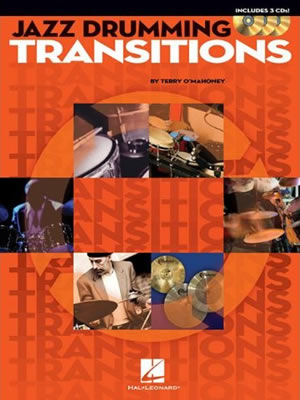
As contemporary jazz changes and incorporates new styles into its mainstream, today's drummers are often faced with new stylistic challenges. This guide will help any drummer learn how to make smooth transitions between different feels and tempos, as well as become comfortable with modern swing styles and time keeping practices.
Drummers will also become familiar with big band chart reading in styles other than traditional swing, which is vital in small group situations and contemporary jazz ensembles. This book is a must-have compendium of crucial tips and tricks for drummers who want to stay on top of their game.
Jazz Drumming Transitions addresses thes musical challenges and provides help with:
• Changing smoothly between various Afro-Cuban/Brazilian feels to a swing feel
• Soloing over different types of ostinatos (vamps)
• Practising metric modulations and tempo changes
• Transitioning from traditional big band swing charts to contemporary jazz ensemble compositions
• Switching from sticks to brushes (or vice versa)
• Changing from one tempo to another
The three included CDs provide dozens of examples and songs for practising the skills learned in the book.
REVIEWS ![]()
Jazz Drumming Transitions is a 71-page book, divided into three chapters, with three supplemental CDs.
In Chapter One: Groove Transitions, Terry explains and demonstrates a variety of ways to move from a groove with a duple feel to a groove with triple feel, and vice versa. This includes Rock to Swing, Bossa Nova to Swing, Samba to Swing, Mambo to Swing, Songo to Swing, Mozambique to Swing, Afro-Cuban 6/8 to Swing, Guaquanco to Swing, and so on.
Chapter Two: Charts and Lead Sheets takes the concepts from Chapter One, but takes it a step further by giving notation examples from musicial situations in which you may need to "transition" from one groove feel to the next. Besides the stylist changes, transitions such as double-time and cut-time to common time, as well as metric modulations are also covered.
Chapter Three: Original Tunes contains seven tunes, all composed with the standard big band swing styles in mind. Terry analyses each chart, giving tips, advice and segment examples on how to approach each tune. It's worth noting that just because these charts are written for "big band", it doesn't mean the group performing the tune has to be physical large in the way of instrumentation; any size ensemble will do.
The book comes with three supplemental CDs which provide audio examples, with and without drums, for each exercise and transition in the book. Suffice to say that with all this materia l, the sizeable length of audio examples, not to mention the seven full compositions, all with and without drums, Jazz Drumming Transitions is far more than just an educational book on musical transitions — it's a play-along package as well!
At first I felt like the audio examples were sometimes too long; it took a long time to get to the actual musical transition. I soon realized that this was only true for the examples at slower tempos. Despite my "feeling", the consistentcy through all of the examples, maintaining the number of measures to establish the groove before transitioning, was a wise decision.
After several hours of looking over and examining the book and three CDs, I came away feeling ... what a wonderful educational package! The book is great — saturated with some truly beautiful play-along compositions.
I would highly recommend Jazz Drumming Transitions to the intermediate and advanced drummer who is already well versed in jazz time keeping as well as the various Afro-Cuban and Brazilian music styles. Teachers and students alike, especially those in higher-learning institutions, will want to add this book/cd package to their educational library.






